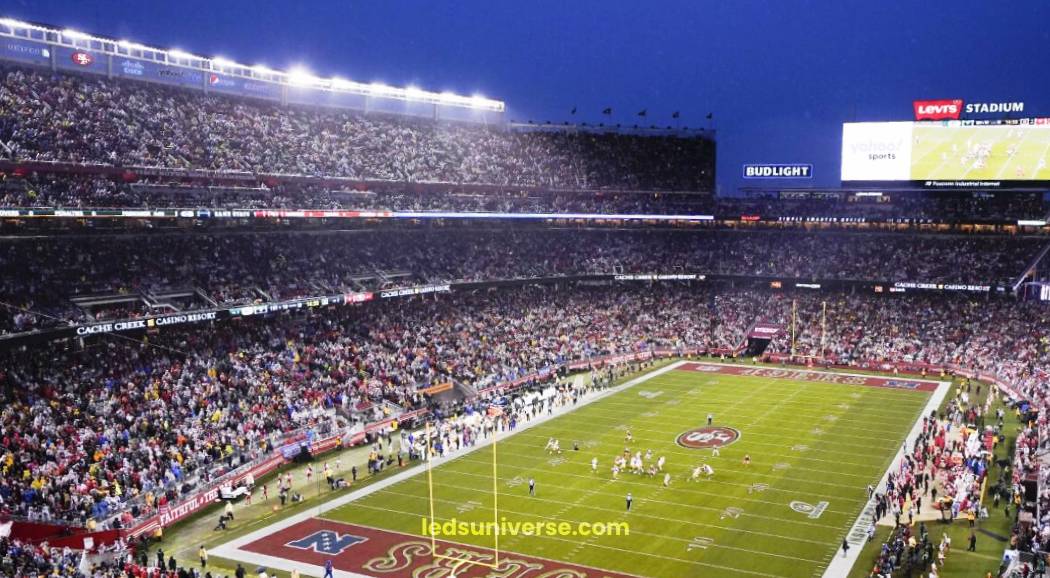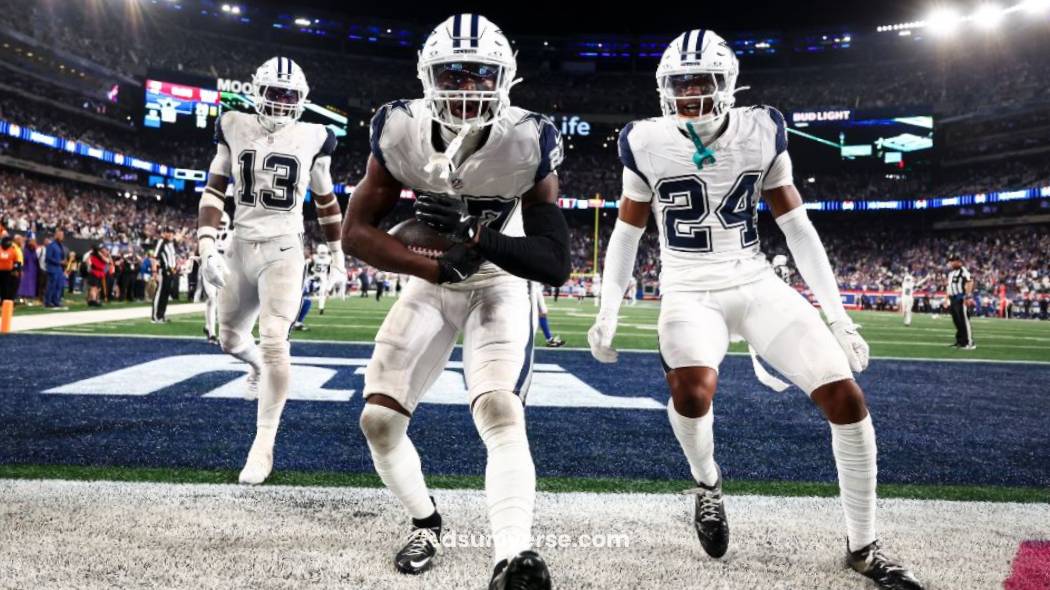When the sun sets, the excitement of a football game doesn’t have to fade with the daylight. Lighting a football field is a complex process that goes beyond simply installing lights. It involves strategic planning, substantial financial investment, and a careful balance between technology, environmental concerns, and community needs.
Reach out for free lighting consultation
| Cost Category | Description | Estimated Costs ($) |
|---|---|---|
| Infrastructure and Fixture Installation | Costs for light fixtures, poles, wiring, control systems, and installation labor. Can vary depending on the type of system and location. | 120,000 – 300,000 (depending on system type and location) |
| Permits and Safety Inspections | Permit applications, inspections, compliance fees, and public hearings for projects near residential areas. Costs can vary by jurisdiction. | 5,000 – 20,000 (varies by location and complexity) |
| Engineering and Design Consultation | Consulting fees for engineers and lighting designers to ensure proper system planning and regulatory compliance. | 10,000 – 25,000 (depending on complexity) |
| Energy Consumption (Metal Halide) | Energy consumption of metal halide lamps. Estimated annual electricity cost based on usage. | 8,400 (annual for metal halide systems) |
| Energy Consumption (LED) | Energy consumption of LED lamps. Reduced power consumption and associated cost savings. | 3,600 (annual for LED systems) |
| Maintenance and Repair (Metal Halide) | Routine maintenance such as bulb replacement, lens cleaning, and re-aiming for metal halide systems. | 100 – 200 per bulb replacement, plus labor costs |
| Maintenance and Repair (LED) | Routine maintenance for LED systems, which have longer lifespans and lower maintenance needs. | Minimal, many LED systems have a lifespan of 50,000 to 100,000 hours |
| System Monitoring and Diagnostics | Remote monitoring services that track system performance and notify operators of issues. Subscription-based services may be required. | 500 – 2,000 (annual subscription for monitoring systems) |
| Staffing and Scheduling | Costs for staffing during events and practices. Includes part-time technicians and training. | Varies, can be a few thousand dollars for part-time technicians or automated systems |
| Cost Over Lifespan (Metal Halide) | Total cost over 15 years for metal halide systems, factoring in installation, energy use, and maintenance. | 150,000+ (total over 15 years for metal halide systems) |
| Cost Over Lifespan (LED) | Total cost over 15 years for LED systems, with energy and maintenance savings offsetting the higher initial cost. | 80,000 – 100,000 (total over 15 years for LED systems) |
| Rebates and Incentives | Rebates or incentives for upgrading to energy-efficient LED lighting. Potential savings through government or utility programs. | 5,000 – 50,000 (depending on the program and savings) |
| Depreciation and Asset Management | Depreciation of lighting systems over time, which affects long-term financial planning and asset management. | Depreciation schedules vary based on accounting standards and asset category |

Table of Contents
ToggleThe upfront investment in lighting begins with the installation process. This phase includes the purchase of light fixtures, poles, wiring, and control systems. Traditional metal halide systems generally cost between $120,000 and $200,000 for a full-sized football field. LED systems, which are becoming more popular due to their energy performance, tend to cost more upfront, ranging from $150,000 to $300,000 depending on brand, lumens output, and coverage area.
Installation fees can include contractor labor, engineering assessments, foundation construction for lighting poles, trenching for wiring, and equipment rental. Depending on the field location and existing infrastructure, these costs might add another $50,000 to $100,000. In areas where older systems are being replaced, additional expenses may be incurred for removing outdated equipment and upgrading electrical systems. Specialized lighting designs may be required for multipurpose fields or venues expecting televised events, further increasing complexity and associated costs.
Before the lighting system becomes operational, approvals from local regulatory authorities are typically required. This process may involve permit application fees, electrical inspections, and compliance with codes regarding light spillage, pole height, and environmental impact. These costs, while not as large as physical installation, still range from $5,000 to $20,000 depending on local jurisdiction and the complexity of the installation.
Some municipalities also require public notification or hearing procedures, especially when projects are being constructed near residential zones. Legal and consulting fees can arise in these instances, particularly if environmental impact studies are mandated.
Lighting systems require professional planning to meet visibility, safety, and broadcast requirements. Hiring engineers and lighting designers can cost an additional $10,000 to $25,000. These experts assess field dimensions, orientation, player and spectator needs, and regulatory compliance to optimize placement and performance of fixtures.
Ongoing operating expenses form a recurring portion of a football field lighting budget. Metal halide lights can consume about 30 to 35 kilowatts per hour for a standard setup. If the lights are used for five nights per week over a ten-month season, this could lead to an annual electricity usage of over 70,000 kilowatt-hours. At an average electricity cost of $0.12 per kilowatt-hour, the yearly expense amounts to around $8,400.
LED systems consume less energy, often cutting power usage by half or more. A similar field using LEDs might only draw 15 to 18 kilowatts per hour, lowering electricity bills to around $3,600 annually under the same usage conditions. The choice of control systems, including dimming features and motion sensors, can further reduce energy demands. Smart lighting technologies that allow for scheduled illumination and adaptive brightness have become more widely available and can drive down operational costs further.
Maintenance costs include routine cleaning of fixtures, lens replacement, lamp re-aiming, and checking control panels. Metal halide lamps typically require replacement every 6,000 to 15,000 hours, which translates to every 2 to 4 years with regular use. Each replacement bulb costs between $100 and $200, and a full field may have between 30 and 50 fixtures.
LED lighting requires far less maintenance due to a lifespan of 50,000 to 100,000 hours. Many LED systems offer ten-year warranties, minimizing maintenance expenses. However, unforeseen repair costs, such as damage from weather events or electrical surges, can add variability to annual budgets.
Modern systems often include remote monitoring features that alert operators to outages or performance degradation. Subscription services or software licenses may be required for access to real-time diagnostics and historical usage data. Annual fees for such platforms can range from $500 to $2,000, depending on system complexity and service levels.
Operational costs also include staffing needs for system operation, particularly during events. While modern systems can be automated, manual supervision is often required during games or practices. Some facilities hire part-time technicians to manage lighting, costing a few thousand dollars each season.
In large stadiums, lighting control may be integrated with audiovisual production or scoreboard systems, requiring coordination among multiple personnel. Some programs also account for training time to ensure that staff or volunteers are familiar with system controls and emergency procedures.
Evaluating the total cost of ownership over 10 to 20 years paints a more accurate picture than focusing solely on upfront expenses. Metal halide systems, although cheaper to install, incur higher long-term costs due to electricity consumption and frequent maintenance. Over a 15-year period, the combined operating and maintenance costs can exceed $150,000.
In contrast, LED systems, despite their higher initial cost, can lead to long-term financial efficiency. Reduced energy bills and infrequent maintenance often offset the upfront premium within 5 to 7 years. Over 15 years, an LED system may cost $80,000 to $100,000 in operating and maintenance expenses, potentially saving tens of thousands of dollars over time.
The evaluation of lighting systems often includes return on investment modeling, especially when lighting is expected to contribute to nighttime attendance, advertising opportunities, or televised events. Increased usage hours, combined with reduced per-hour operating cost, can make LED systems especially attractive.
Some energy providers and governmental bodies offer rebates or incentives for upgrading to LED lighting. These programs may cover a portion of the installation costs, ranging from $5,000 to $50,000, depending on the project scale and energy savings expected. Accessing such incentives typically requires documentation of projected savings, proof of purchase, and sometimes a professional energy audit.
In certain regions, state or national programs encourage upgrades to sustainable infrastructure. This could include tax deductions, low-interest loans, or grants. Local utilities may also offer performance-based incentives tied to demonstrated energy savings over the first few years of use.
Rebates are not guaranteed and often require early application during the project planning phase. Working with experienced consultants who are familiar with funding programs can increase the likelihood of securing such benefits.
Lighting systems are long-term assets subject to depreciation. Properly tracking depreciation over time helps organizations manage their balance sheets and plan for eventual replacement. Annual depreciation varies depending on whether the system is categorized as equipment or infrastructure, and local accounting standards.

Football field lighting can affect surrounding neighborhoods, especially in residential areas. Light spillover, glare, and skyglow may prompt complaints from nearby residents. Addressing these concerns often involves selecting lighting fixtures with shielding capabilities, angled beams, and cut-off optics. These adjustments ensure the illumination is focused solely on the field, reducing interference with nearby properties.
Zoning laws and community feedback sessions may also influence the lighting design and hours of operation. Some communities implement curfews requiring lights to be turned off by a certain time to reduce disturbances. Modern LED systems offer better directionality, which helps manage these concerns more effectively than older lighting types.
In addition, community engagement sessions during the design phase can help align field usage with neighborhood expectations. When projects take public input into account, they are often more broadly supported and less likely to experience resistance or delays.
The environmental impact of lighting systems goes beyond light pollution. Energy consumption contributes to greenhouse gas emissions, especially if the electricity comes from fossil fuel sources. LEDs, consuming less energy, help reduce the overall carbon footprint of a facility.
Moreover, LEDs do not contain hazardous materials like mercury, which is found in some traditional lamps. Disposal of metal halide lamps requires special handling and may involve additional fees for proper recycling or waste management.
The move toward eco-conscious facility management has encouraged more fields to adopt solar integration or renewable energy offsets for their lighting systems. While solar-powered lighting is still developing for large-scale sports applications, hybrid models or grid-tied solutions with renewable inputs are increasingly part of planning discussions.
Some programs also involve carbon offset purchases or partnerships with local environmental groups to balance the facility’s emissions with broader sustainability projects. These initiatives may not directly impact lighting performance but contribute to a more holistic facility management strategy.
Extended field usage due to lighting can increase nighttime traffic and ambient noise. Event planning that incorporates staggered start times, noise reduction protocols, and parking management can help minimize disruption to surrounding neighborhoods. Facilities may also coordinate with local transportation agencies or law enforcement during larger events.
Lighting a football field is more than a one-time expense; it is a long-term investment that involves installation, operation, and community impact. LED systems, while more expensive upfront, offer a more manageable financial path through energy and maintenance savings. Factoring in utility incentives and adopting community-friendly designs can make lighting upgrades more feasible and sustainable. As technologies evolve and regulations shift, careful consideration of both costs and benefits will support the continued enjoyment of nighttime football activities for years to come.